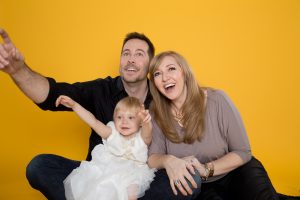Tracy Ryan of CannaKids moves heaven and earth to bring medically sound, cannabis-based solutions to her own and other stricken children.
What if, out of the blue, your infant daughter was diagnosed with cancer? A rare brain tumor that may or may not turn malignant, that acts unpredictably and can’t be stopped with chemotherapy. Chemo will only slow the tumor’s horrific growth, spider-webbing its way around your little girl’s optic nerve. The tip off? An uncontrollable shaking of one eye that started without warning, a condition with a very scary-sounding name called nystagmus.
What would you do?
Meet Tracy Ryan, chief executive officer of her own busy social media marketing agency and self-professed “mama bear” to Sophie, her longed-for only daughter. While managing a high-powered career and large staff, Ryan married her husband, Josh. The two wanted to begin a family right away. Married in September 2012, Tracy Ryan was pregnant by the following January. Sophie was born in October 2013. Everything was perfect. Then, a sudden change caused things to start moving very quickly.
“These types of tumors are typically slow-growing, but at the time, we didn’t know that Sophie’s was not a slow-growing [optic pathway] glioma,” Ryan said.
She speaks like the veteran of many conversations with doctors and nurses, throwing out words like vincristine-carboplatin (chemo drugs used to treat Sophie). Ryan can read an MRI with the skill of a technician; Sophie has had 14 of them. “It’s categorized as ‘slow-growing,’ but we found hers acts aggressive when she’s not on treatment,” Ryan said. “During the observation period, her tumor hit a growth spurt and she ended up having to have brain surgery. She was in the hospital recovering from that on her first birthday.

“They told me over the phone, when they called me to tell me the tumor had hit a growth spurt… They told me, if it did turn out to be an aggressive glioma, she wouldn’t live to see her second birthday,” Ryan recalled. “I was about to leave for work. I was standing in my bedroom and I literally collapsed to the bed and then the floor because I just lost it.
“We started cannabis when she was nine months old,” Ryan continued, explaining the cannabis treatment began just weeks before Sophie started her first round of chemotherapy. “Chain of events: diagnosed at eight and half months old; within two weeks we were connected to [former actress and talk show host] Rikki Lake and [filmmaker] Abby Epstein; another two weeks, so a month later, we had cannabis oil in our hands and Sophie was videotaped taking her first dose. This was during the time we were in an observation period, and when we started giving her the cannabis, the nystagmus in her eye started to resolve. We all—including her medical team—thought the cannabis was working.”
At first, the Ryans reacted like any parents would: They were devastated. Then, Tracy Ryan decided to do the only things she could do: explore treatments that might help her daughter; research everything from nutrition to chemotherapy and alternate therapies to treatment financing. She also found strength in reaching out to other parents in the same situation. Using a Facebook page called “Prayers for Sophie,” she contacted other moms whose children had cancer, epilepsy, autism, and other serious, disabling conditions.
“It’s evolved and become this really beautiful community where we all support each other and help each other out, give each other guidance,” Ryan said. “I’m admin on the page, so I go in every day, and if there are questions to be answered, I’ll jump in and answer. I’ve become a dosing expert because of what I’ve had to do on a regular basis.
“As my experience with cannabis evolved, I realized there were a couple of really good oil makers out there, not a lot,” she continued. “I wanted to be more than just a voice on a page—I wanted to give back. And because of me running my own company for a number of years, I knew how to build a business, build a brand. I already had a team in place.”
Ryan founded non-profit CannaKids and Saving Sophie specifically to supply seriously ill children with medicinal cannabis oils, as well to provide information and resources their overwhelmed parents otherwise would have to hunt down on their own. Ryan, a public speaker, also educates healthcare professionals interested in learning more about medical marijuana. CannaKids has two registered nurses on-staff, dosing experts who assist patients. In March 2015, the organization rolled out its own line of medicinal oils.
“I didn’t want to go to the black market or the dispensaries because I wanted to make my own medicine,” Ryan said. “I brought an investor in that funded a grow operation—a 1,000-square-foot greenhouse on twenty acres of land—and we started to grow. We worked with Dr. Bonni Goldstein to identify the terpene profile we wanted, so our medicines are chemo-theraputic, anti-tumoral, anti-anxiety, and appetite-stimulating, because we wanted it for pediatric cancer.”
Goldstein, Sophie’s pediatrician and cannabis doctor, said unlike Sophie—who started cannabis treatment soon after diagnosis—most of her patients have been through a whole regimen of traditional therapies with little success.
“The group that comes to see me are people that are not getting very good results,” Goldstein explained. “They were told, ‘There is nothing for your child.’ Or, ‘Well, we know you tried twenty medications but you can try twenty more.’ The reality is those children and adults are not going to respond, so it does feel like a miracle [when they see good results from cannabis].”
Goldstein served her residency at Children’s Hospital Los Angeles from 1990-93 and was chief resident from ’93-’94. After that, she practiced emergency pediatric care, first as a critical-care transport doctor, and then in the pediatric emergency department for twelve years. In 2008, during a break from work to spend more time with her family, a friend who had become seriously ill was interested in trying cannabis for pain relief and approached her for advice. The scientific data turned Goldstein into an advocate for patients trying to access medical marijuana.
“You know, I didn’t know anything,” Goldstein said. “I helped her, and I really didn’t want to go back to emergency medicine with the hours that are so difficult for someone who wants to be a mother. I got a job working part-time in a medical cannabis specialty office in Long Beach, California, and subsequently bought a medical practice that focused on medical cannabis specialty, which is where I am now. It’s called CannaCenters. We do not do primary care or pediatric care—we are a practice dedicated to helping patients who use medical cannabis for their serious and chronic conditions.
“Since 2008, I’ve probably seen 7,000-plus patients. At one point, I kind of calculated back and figured we were close to 10,000 visits over the years, so I’m deep in it.” She laughed.
“I want to tell you they’re patients that could get lots and lots of pain medication and sleeping pills,” she pointed out. “Their doctors would gladly give it to them. But despite the side effects and risk of addiction, they’re not addicts and they want to function. Anyone who reads this article, if there’s one thing you take away: Why wouldn’t you use a non-toxic medication that lacks side effects, if it gives you the benefit you’re looking for? It makes no sense to take medicine that has a lot of side effect and addiction problems.”

“Oncologists are sending me patients; primary care doctors; developmental pediatric doctors that have children with seizures or autism or psychiatric disease. Some pediatric neurologists are referring patients.”
All mammals have a little-known biological system called the endocannabinoid system that enables the body’s response to cannabinoids like CBD and THC. Goldstein compares low cannabinoid levels in patients to a condition like diabetes, which is the result of insufficient insulin. Like a diabetic who’s able to maintain health by supplementing with insulin, patients who have cannabinoid deficiencies can see so-called miraculous results when they take supplemental cannabinoids. The only source of cannabinoids outside the body is the marijuana plant.
“But it’s not a miracle; it’s just science,” Goldstein said. For young doctors in medical schools, marijuana is still held to be a “drug of abuse,” she noted, allowing antiquated beliefs to override evidence from available research and a wealth of anecdotal accounts. For physicians awaiting more current data, a rush of clinical trials is well underway as patients and providers become more interested in the potential for medical marijuana. Eventually, Goldstein intends to publish her findings from the practice at CannaCenters.
CannaKids’ Ryan soon will start clinical trials with research scientist Dr. Shiva Ayyadurai in a new business venture called Endosolve. Using Dr. Ayyadurai’s digital model of the endocannabinoid system, they will begin to analyze and document the effects of cannabinoids on various diseases and conditions, the first of which will be optic pathway glioma.
So, how’s Sophie? After an initial thirteen months of chemo combined with cannabis therapy, her results have been amazing and atypical. She’s also experienced a few setbacks. She recently started another round of chemo, after it was determined the best results come from a combination of chemotherapy and cannabis treatment.
“She is now three,” Ryan said. “She is hilarious, brilliant, sleeps great, eats like a champ, super-funny, so loving and outgoing. [Cannabis] hasn’t done anything negative to her whatsoever. If anything, it’s protected her little body from all of these toxic treatments. She’s never gotten neutropenia, which is when the white blood count drops below a healthy level. She’s never gotten neuropathy in any of her limbs, which is the tingling nerve damage that can happen from the vincristine that she’s on. She’s never once spiked a fever, ever, on chemotherapy. And they told us that at some point she would be hospitalized for fevers. Her bone marrow repaired itself. She has a full head of hair. She has always gained weight and grown while on chemo treatments. And she’s done fantastic.”
Since going public with Sophie’s story, Ryan has received attention from media outlets like Huffington Post and appeared in a National Geographic series about medical marijauna. Sophie also will take part in two documentaries: Weed the People being produced by cannabis advocates Rikki Lake and Abby Epstein, and the movie Saving Sophie, being produced by her mom.
 A towheaded child with a cherubic face, Sophie has no idea every day is a miracle. She has no idea how determined her mom is to find any option, even if it means pioneering a new approach. Sophie is unaware that she and her mother are leaving little miracles along the way so other children and their parents may navigate dark and unknown territory.
A towheaded child with a cherubic face, Sophie has no idea every day is a miracle. She has no idea how determined her mom is to find any option, even if it means pioneering a new approach. Sophie is unaware that she and her mother are leaving little miracles along the way so other children and their parents may navigate dark and unknown territory.










